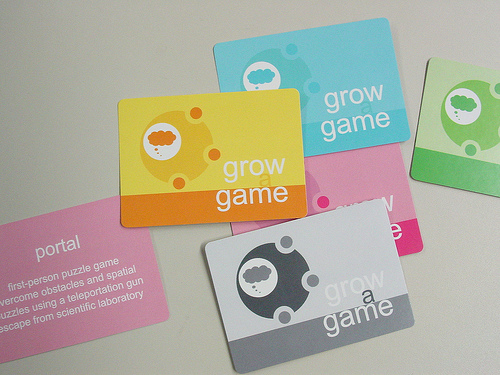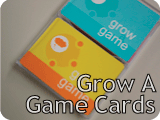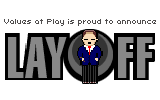The Art of Game Design
Designing a great game requires a subtle grace. Even the loudest, most garish, monster slaughter of a first person shooter requires a deft hand and critical eye in the design phase. While I respect and enjoy big sandbox games, massive RPGs, and photorealistic car racing, there is no question that the greatest games of all time are the simplest. One of the oldest board games, Go, uses a grid and two sets of monochromatic stones. It is also a game of such sprawling complexity and boundless emergence that scientists have yet to build the computer to defeat the best human players. Checkers, poker, Tetris, these are games of few rules and endless entertainment. It is important that we as game designers think about these examples, and take a minute to contemplate the process of game design.
The Values At Play team has just produced a finished version of our Grow A Game cards, and they were a big hit in our workshops during this year’s Game Developers’ Conference. Earlier versions of the cards have been used at universities around the country and at VAp workshops, but we now have a polished product to offer. The cards are meant to serve as the Leatherman tools for game design. They can be used to analyze existing games or to imagine new ones, the cards help stimulate brainstorming sessions alone or in groups and even work as a game design game. We’ll be facilitating workshops with them throughout the year, and will keep the blog updated about where and when those will be. To learn more about the cards just go to the Game Tools section of the website.
Pink Godzilla has their own game development card game, butit’s meant to be a fun game about game development as opposed to a functional tool. It sounds great, and the cards have a very cute bubblegum manga look.
As reviewer for Joystiq wrote: This game was clearly made for me … Dev Kit’s a blast to play … It’s an addictive little game … It’s not going to make you a better game developer, but you’ll feel like one for at least a little while.”
Game Game is another design card game that deals with the experience of pitching game ideas in a game company It’s available for free download from Aki Jarvinen.
In GameGame, players compete in designing games. Players collect and trade cards in order to create a complete game design. In between, one player gets to play a game publisher, while the other players try to sell their game concepts to her.
The Escapist has a good article about the reality behind Game Game. Game design and pitching sessions involve a competitiveness and jockeying that some find exhilarating and others find exhausting.
Design, like play, always feels most natural and fun when you’re with others. Just as a move in a game influences the next, so too does the designers’ back-and-forth interaction influence the outcome of game design. While it can be played solo or co-op, it can be competitive as all hell, too. I’ve worked on pitches that were literally make or break for landing IPs or funding, and all the while I was acutely aware that I wasn’t the only one furiously figuring out a concept, a pitch and a prototype design. It’s head to head, team vs. team, not unlike the massive guild-vs.-guild battles in MMOGs, and often there’s millions of dollars at stake.
Unfortunately, we have PvP matches, too. The stories are legend, and all game developers have them. Instead of pulling together to make a game, the team pulls itself apart, and the game design game becomes one of politics and manipulation, pitting one group, one person, against another.
There’s a little game that comments pretty directly on the antagonism within a game development team. The Truth About Game Development is a quick online game that offers a black humor critique of life at a game company. You play the part of a game producer and your job is to produce the best game you can as cheaply as possible.
Mostly you just try to motivate the lazy ass game developers by killing them.
Yep, pretty bleak. But what makes the game notable is that it’s not just a satirical commentary; it’s actually an enjoyable game. Some of the player responses sum up exactly what makes it a successful game. One wrote, “You have merged the physical factor (slaves on the stairs), undercover cerebral mechanics (salary and time management) and random elements (soda, “Guitar Hero” controller) very neatly.” The game is humorous without being nonsensical and critical without being dull. Another player wrote, “Now that I’ve played it, I take back the ‘simple’ statement. It’s not simple – it’s succinct.” There is a key distinction there between simple and succinct, the former could be lacking, but the latter is cohesive. Go has few elements, but there is no element that would improve the game; it is complete, elegant, succinct.
Crafting a succinct game requires many many iterations, but a little study beforehand doesn’t help. Tracy Fullerton, a game design star and VAP advisory board member, has just released a new edition of her game design book that should be required reading for any game designer.Game Design Workshop, Second Edition: A Playcentric Approach to Creating Innovative Games
grounded in solid theory, but written in an accessible language and it’s “playcentric” focus is refreshing for a textbook. Games get better through playtesting. Fullerton understands this, and after an introductory section devoted to learning game concepts, part two is a practical guide to designing a game. The book covers topics like brainstorming, prototyping, playtesting, and balancing.
It’s great to see organizations and individuals developing tools that help democratize the game creation process. Helping developers consider the initial design stage of their games can only lead to better products in the end. We’re really proud of the Grow A Game cards, and think they can help to both professional and amateur game designers create more innovative, expressive games. Whether the goal is creating didactic training games, evocative activist games, or large production console games, the VAP methodology can improve quality.








I wish I’d had access to the Grow a Game cards before I finished the second edition of Game Design Workshop. I would have loved to include some examples of brainstorming with them! Next time for sure!